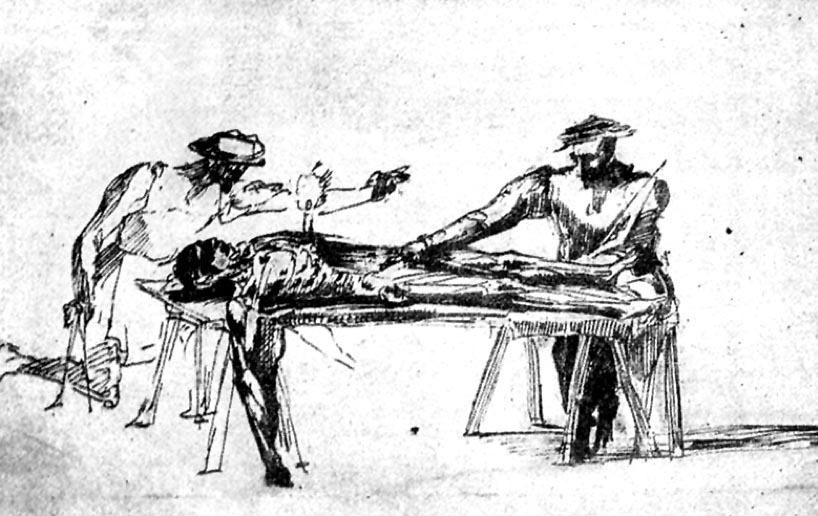1500 CE – 2000 CE
drawing Breath >< Gut Feelings
An Experimental Anatomical Art Lab for Contemporary Dance
Nina Sellars
Introduction
At its etymological origins in ancient Greek, the word anatomy literally means to cut. A vital process, the cut of anatomy can be broadly defined as a twofold act: the physical action of cutting the body asunder, and the visual cut of image-making which carves out a particular representation of the body. By exploring the visual archives of anatomy, insight can be gained into how certain ways of seeing are formed (from a contingent coalescing of practices, materials, and ideas) and performed (sustained as enactments of visual knowledge, which can be also viewed as iterations that are open to change, i.e., offering us the possibility of seeing, and doing, otherwise). (3) Inviting the students to be open to experimentation, visual artist and curator – Dr Nina Sellars – together with choreographer and dancer – Professor Carol Brown (Head of Dance at the Faculty of Fine Arts and Music) – approach the anatomy archives from their separate spheres of body knowledge. Their intention is to begin with the guts—considered in relation to the history of anatomy and contemporary dance. In particular, the techniques and influence of Brown’s mentor, Aotearoa (New Zealand) dancer and choreographer, the late Shona Dunlop-MacTavish MBE, 1920 – 2019, and her teacher, Viennese dancer and choreographer, Gertrud Bodenwieser, 1890 – 1959. Drawing Breath >< Gut Feelings also incorporates Sellars’ knowledge from her previous work as an anatomy museum curator, body dissector and anatomical illustrator, in addition to her contemporary biological and new media arts practice (4) Moreover, the drawing exercises integrate aspects of Sellars’ sensory experience of having been blind as a teenager and the transitionary phases of ‘almost seeing’ and ‘seeing differently’.
1. Carol Brown, email dialogue between Nina Sellars and Carol Brown, Naarm (Melbourne) Australia, 27/11/2022; unpublished. 2. University of Melbourne, Dance Science & Somatics, graduate course, https://handbook.unimelb.edu.au/2023/subjects/dnce90018 (accessed January 24, 2023) 3. Nina Sellars, “Robert Hooke’s Micrographia: A historical guide to navigating contemporary images,” in Routledge Handbook of Art, Science and Technology Studies, eds., Hannah Star Rogers, Megan K. Halpern, Dehlia Hannah, and Kathryn de Ridder-Vignone (London: Routledge, 2021), 142. 4. Nina Sellars, ‘Fat matters: fluid interventions in anatomy’. In Fluid Matter (s): Flow and Transformation in the History of the Body, edited by Natalie Köhle and Shigehisa Kuryama. Asian Studies Monograph Series 14. Canberra, ANU Press, 2020. doi.org/10.22459/FM.2020 (accessed March 24, 2023).
Drawing Breath >< Gut Feelings
The performance of an anatomy dissection and the living anatomies of contemporary dancers both appear to follow the same directive—to begin by ‘opening’ the abdomen—i.e., one gut is being incisively penetrated, the other appears spatially extended. Historically, in the practice of anatomy the abdominal cavity is the beginning entry point of a dissection. For a contemporary dancer, the guts designate their somatic centre and represent the core of their movement and mass. This notion takes on a particular relevance in regard to the dance techniques of Dunlop-MacTavish and Bodenwieser—in which they call for dancers to ‘reach beyond yourself’, enabled by a strong capacity for core mobility and a ‘freeing up of the pelvis’, (Fig. 1). (1)
In the Drawing Breath >< Gut Feelings studio-lab the choreographic elements of space, body, movement and time, are explored through the performance of anatomy. Essentially, the study of anatomy is the art of visually locating organs in space—this relates both to the physical exploration of the corporeal body and also its pictorial representation in images (Fig. 2). The aim is for the students to contemplate the ways in which anatomical knowledge can be enacted and conveyed and to reimagine it through artistic intervention.
Selected images are used to emphasise the importance of considering the processes, environments and protagonists that are involved in each individual act of studied anatomical observation, (Figg. 3 and 4). The intention is to bring the students’ awareness to the possible insights that can be gained when we give thoughtful attention ‘to seeing ourselves see’—that is, to question our perceptions (Fig. 5). This idea connects to the first half of the studio-lab title, which relates not only to the medium of drawing but also the act of drawing breath.
The idiom, to draw breath, indicates both a movement and a stillness. To take a breath, and to pause. To direct our attention away from the external world and reflect inwards. A transition from exteroceptive to interoceptive body awareness. To locate in this moment of stillness, a perspective—to ask why, and by what means, do we arrive at our particular understandings of the anatomical body? Diaphragmatic breath in dance is a powerful mover of the guts and is engaged here also as a metaphor for a body that is in the process of sensing itself into being—with a focus on the dancers sensing differently, and of knowing anatomy otherwise, beyond the parameters of a single discipline. Yet, most importantly, they are encouraged to follow their gut feelings.
1. Carol Brown, “Entangled histories, part 1: Releasing the Archive,” Journal of Dance & Somatic Practices 9, no. 1 (June 2017): 65; Thomas Kampe, “Entangled histories, part 2: Releasing the de-generate body,” Journal of Dance & Somatic Practices 9, no. 1 (June 2017): 81.








